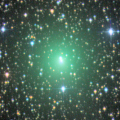
|
Brightening very rapidly. It is already so bright as 7.4 mag (Dec. 2, Marco Goiato). It will approach to the earth in December and January, and it is expected to brighten up to 5 mag. In the Southern Hemisphere, it keeps observable in excellent condition until late January. In the Northern Hemisphere, it keeps extremely low until mid December. But after that, it will be observable in excellent condition.
Date(TT) R.A. (2000) Decl. Delta r Elong. m1 Best Time(A, h)
Dec. 6 7 23.89 -43 26.0 0.940 1.529 105 7.6 2:27 ( 0, 11)
Dec. 13 6 58.13 -41 14.7 0.796 1.477 111 7.0 1:34 ( 0, 14)
|

|
It brightened up to 6.9 mag in autumn (Oct. 17, Marco Goiato). Now it is fading. But it is bright as 9.2 mag still now (Dec. 6, Marco Goiato). It is observable in excellent condition in the Southern Hemisphere. In the Northern Hemisphere, it is observable in the evening low sky in December and January.
Date(TT) R.A. (2000) Decl. Delta r Elong. m1 Best Time(A, h)
Dec. 6 0 45.26 -45 5.5 1.569 1.892 92 9.2 19:44 ( 0, 10)
Dec. 13 0 28.45 -41 23.8 1.767 1.975 86 9.6 19:00 ( 0, 14)
|
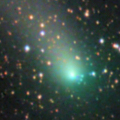
|
The brightness evolution has slowed down before the perihelion passage, and it faded down to 11.6 mag in late October (Oct. 26, Todd Augustyniak). However, an outburst occured around Nov. 10-12, and it brightened by 2 mag. It is bright as 10.4 mag still now (Nov. 29, Seiichi Yoshida). In the Northern Hemisphere, it became unobservable temporarily in December. But it will be observable in excellent condition after January while the comet will be fading. In the Southern Hemisphere, it will keep locating extremely low after this.
Date(TT) R.A. (2000) Decl. Delta r Elong. m1 Best Time(A, h)
Dec. 6 17 48.47 -6 44.0 2.398 1.523 21 10.2 18:18 ( 80, 2)
Dec. 13 17 51.15 -4 41.2 2.454 1.565 19 10.4 18:19 ( 86, -2)
|
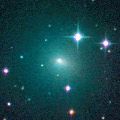
|
It brightened rapidly. Now it is so bright as 10.7 mag (Nov. 24, Uwe Pilz). In the Northern Hemisphere, it keeps observable in good condition until the comet will fade out in next spring. It is not observable in the Southern Hemisphere.
Date(TT) R.A. (2000) Decl. Delta r Elong. m1 Best Time(A, h)
Dec. 6 18 36.51 59 33.6 1.429 1.662 84 11.4 18:18 (142, 39)
Dec. 13 18 49.19 55 4.6 1.529 1.676 80 11.8 18:19 (136, 37)
|
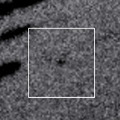
|
After observed as 17.5 mag in early October (Oct. 8, Taras Prystavski), no observations have been reported. However, it must be already very bright as 12 mag. It will brighten very rapidly, up to 10 mag in January. In the Northern Hemisphere, it will be geting higher gradually. In the Southern Hemisphere, it will be getting lower gradually, and it keeps extremely low after January.
Date(TT) R.A. (2000) Decl. Delta r Elong. m1 Best Time(A, h)
Dec. 6 19 48.92 -24 1.9 1.532 1.024 41 12.2 18:18 ( 48, 13)
Dec. 13 20 19.66 -21 58.2 1.493 0.998 41 11.6 18:19 ( 49, 15)
|
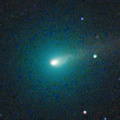
|
Now it is so bright as 10.6 mag (Nov. 29, Seiichi Yoshida). It keeps observable in the morning low sky at the same brightness for a while. In the Southern Hemisphere, it is too low to observe until December.
Date(TT) R.A. (2000) Decl. Delta r Elong. m1 Best Time(A, h)
Dec. 6 13 48.45 -3 41.6 1.826 1.368 47 11.6 5:23 (298, 28)
Dec. 13 14 11.49 -5 28.5 1.830 1.390 48 11.7 5:28 (301, 28)
|
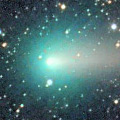
|
The brightness evolution has slowed down just before the perihelion passage. But it brightened up to 6.5 mag in September (Sept. 21, Marco Goiato). Now it is fading. It has faded down to 10.6 mag in October (Oct. 21, Chris Wyatt). It is appearing in the morning sky in the Northern Hemisphere. It will be observable in mid January also in the Southern Hemisphere. It keeps observable in good condition after this, while the comet will be fading gradually.
Date(TT) R.A. (2000) Decl. Delta r Elong. m1 Best Time(A, h)
Dec. 6 15 56.45 -7 55.2 2.367 1.473 19 12.1 5:23 (280, 0)
Dec. 13 15 58.66 -6 48.9 2.411 1.579 25 12.4 5:28 (284, 7)
|
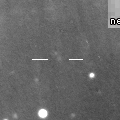
|
It will brighten up to 8-9 mag in 2015 spring. In the Southern Hemisphere, it will become observable in January, then it keeps observable in good condition after that. In the Northern Hemisphere, it keeps extremely low and hard to observe from December to 2015 June. It will be observable in good condition after June while the comet will be fading gradually.
Date(TT) R.A. (2000) Decl. Delta r Elong. m1 Best Time(A, h)
Dec. 6 15 10.43 -16 43.5 2.716 1.857 23 13.3 5:23 (294, 4)
Dec. 13 15 28.76 -18 2.1 2.641 1.813 26 13.0 5:28 (297, 6)
|
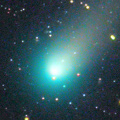
|
It brightened rapidly in outburst in mid October in 2013. Now it is fading. It has already faded down to 13.0 mag (Oct. 18, Con Stoitsis). In the Southern Hemisphere, it keeps observable in good condition for a long time until the comet fades out. In the Northern Hemisphere, it keeps extremely low after this.
Date(TT) R.A. (2000) Decl. Delta r Elong. m1 Best Time(A, h)
Dec. 6 22 17.26 -44 13.3 4.047 3.809 69 13.4 18:18 ( 11, 10)
Dec. 13 22 24.65 -43 20.9 4.192 3.875 64 13.6 18:19 ( 15, 10)
|
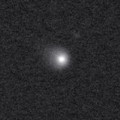
|
Now it is 14.1 mag (Nov. 17, Chris Wyatt). Getting brighter than originally expected, and it is already visible visually. It is expected to brighten up to 4 mag from autumn to winter in 2015. It is observable in good condition in the Southern Hemisphere until the highlight, or in the Northern Hemisphere after the highlight.
Date(TT) R.A. (2000) Decl. Delta r Elong. m1 Best Time(A, h)
Dec. 6 22 22.88 -25 32.0 4.883 4.725 75 13.7 18:18 ( 14, 28)
Dec. 13 22 22.44 -25 22.5 4.930 4.654 68 13.6 18:19 ( 21, 26)
|
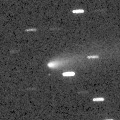
|
Now it is 13.9 mag (Nov. 29, Seiichi Yoshida). It is fainter than originally predicted by 2 mag. In the Northern Hemisphere, it keeps observable at 14 mag in excellent condition from 2014 summer to 2015 spring. It locates somewhat low in the Southern Hemisphere.
Date(TT) R.A. (2000) Decl. Delta r Elong. m1 Best Time(A, h)
Dec. 6 11 8.42 17 42.3 1.759 2.050 92 14.0 5:23 (326, 70)
Dec. 13 11 18.75 17 18.6 1.701 2.065 96 13.9 5:28 (341, 71)
|

|
Now it is not observable. It will appear in the morning sky again in January.
Date(TT) R.A. (2000) Decl. Delta r Elong. m1 Best Time(A, h)
Dec. 6 16 39.93 -29 14.7 7.065 6.089 7 14.1 5:23 (292,-20)
Dec. 13 16 46.22 -29 24.2 7.055 6.087 9 14.1 5:28 (296,-15)
|
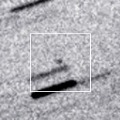
|
It will brighten very rapidly, and will brighten up to 11 mag from January to February. In the Southern Hemisphere, it will be observable in the morning sky after late February while the comet will be fading. It is hardly observable in the Northern Hemisphere.
Date(TT) R.A. (2000) Decl. Delta r Elong. m1 Best Time(A, h)
Dec. 6 15 41.52 -8 23.4 2.281 1.410 21 14.8 5:23 (283, 3)
Dec. 13 16 4.69 -10 29.1 2.237 1.373 21 14.1 5:28 (286, 4)
|
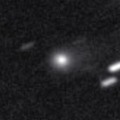
|
Now it is 14.8 mag (Sept. 16, Taras Prystavski). It is expected to brighten up to 13 mag and to be observable in good condition in 2015. It becomes unobservable temporarily from October to January.
Date(TT) R.A. (2000) Decl. Delta r Elong. m1 Best Time(A, h)
Dec. 6 16 19.45 -12 31.0 4.592 3.634 12 14.4 5:23 (281, -7)
Dec. 13 16 30.05 -12 52.5 4.554 3.615 15 14.4 5:28 (284, -3)
|
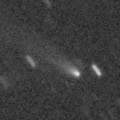
|
Now it is 14.4 mag (Oct. 20, J. Gonzalez). It will be observable at 14 mag in excellent condition in winter.
Date(TT) R.A. (2000) Decl. Delta r Elong. m1 Best Time(A, h)
Dec. 6 23 7.85 -6 41.0 0.985 1.415 91 14.7 18:18 ( 3, 48)
Dec. 13 23 21.93 -4 12.7 1.002 1.391 88 14.7 18:19 ( 9, 51)
|
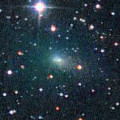
|
Now it is 13.7 mag (Nov. 29, Seiichi Yoshida). It will be observable at 14 mag in excellent condition from October to December.
Date(TT) R.A. (2000) Decl. Delta r Elong. m1 Best Time(A, h)
Dec. 6 5 20.30 34 57.5 0.800 1.772 165 14.7 0:24 ( 0, 90)
Dec. 13 5 14.48 36 21.1 0.818 1.791 166 14.9 23:46 (180, 89)
|
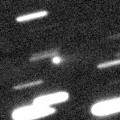
|
Now it is 16.0 mag (Oct. 24, C. Bell). It will brighten up to 15 mag and will be observable in excellent condition from November to February in the Northern Hemisphere. It locates somewhat low in the Southern Hemisphere.
Date(TT) R.A. (2000) Decl. Delta r Elong. m1 Best Time(A, h)
Dec. 6 7 3.10 27 36.4 1.578 2.476 149 14.9 2:06 ( 0, 83)
Dec. 13 6 58.72 27 11.3 1.538 2.476 157 14.8 1:34 ( 0, 82)
|
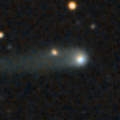
|
Now it is 14.4 mag (Oct. 27, Sandor Szabo). It keeps 15 mag for a long time from 2014 to 2015. It is observable in excellent condition in 2014 in the Southern Hemisphere, or in 2015 in the Northern Hemisphere.
Date(TT) R.A. (2000) Decl. Delta r Elong. m1 Best Time(A, h)
Dec. 6 0 11.66 -23 19.9 3.705 3.974 98 14.8 19:11 ( 0, 32)
Dec. 13 0 10.43 -21 33.3 3.793 3.961 92 14.9 18:43 ( 0, 34)
|
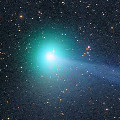
|
It brightened up to 6.0 mag from July to August (July 24, Maik Meyer). Now it is fading. It has already faded down to 13.1 mag (Nov. 15, Uwe Pilz). It is already unobservable in the Southern Hemisphere. It will be unobservable in late December also in the Northern Hemisphere.
Date(TT) R.A. (2000) Decl. Delta r Elong. m1 Best Time(A, h)
Dec. 6 19 35.84 -2 54.7 3.291 2.685 44 15.0 18:18 ( 66, 26)
Dec. 13 19 40.66 -3 8.2 3.462 2.775 39 15.3 18:19 ( 70, 21)
|
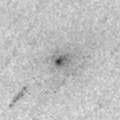
|
Now it is 15.5 mag (Oct. 28, Sandor Szabo). It keeps 15 mag from autumn to winter, but it is extremely diffuse. It moves southwards fast in winter.
Date(TT) R.A. (2000) Decl. Delta r Elong. m1 Best Time(A, h)
Dec. 6 9 40.36 -10 16.0 1.449 1.908 101 15.1 4:42 ( 0, 45)
Dec. 13 9 41.28 -14 39.8 1.422 1.936 105 15.1 4:16 ( 0, 40)
|

|
Now it is 13.5 mag (Oct. 25, Seiichi Yoshida). It keeps bright as 13-14 mag for a long time from 2013 to 2014.
Date(TT) R.A. (2000) Decl. Delta r Elong. m1 Best Time(A, h)
Dec. 6 21 23.51 -23 35.2 3.628 3.293 62 15.1 18:18 ( 29, 26)
Dec. 13 21 31.89 -22 44.8 3.726 3.305 57 15.2 18:19 ( 34, 24)
|

|
It brightened up to 11-12 mag in 2012. It has already faded down to 14.9 mag (Aug. 12, Taras Prystavski). Appearing in the morning sky again. It will be observable at 15 mag in good condition again in 2015.
Date(TT) R.A. (2000) Decl. Delta r Elong. m1 Best Time(A, h)
Dec. 6 12 9.76 -10 14.0 8.946 8.617 67 15.1 5:23 (325, 38)
Dec. 13 12 9.29 -10 22.1 8.863 8.654 74 15.1 5:28 (335, 41)
|
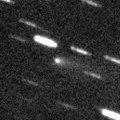
|
Now it is 14.0 mag and visible visually (Nov. 29, Seiichi Yoshida). It keeps observable for a long time after this while the comet will be fading gradually.
Date(TT) R.A. (2000) Decl. Delta r Elong. m1 Best Time(A, h)
Dec. 6 9 58.73 1 20.4 2.026 2.431 102 15.1 5:01 ( 0, 56)
Dec. 13 10 0.73 0 49.4 1.979 2.473 108 15.2 4:35 ( 0, 56)
|
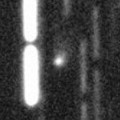
|
Now it is 16.1 mag (Nov. 13, J. Oey, P. Camilleri, H. Williams). The brightness evolution is somewhat slow. It keeps 15-16 mag for a long time from 2014 autumn to 2015 autumn. In the Southern Hemisphere, it keeps observable in excellent condition for a long time. In the Northern Hemisphere, it is unobservable until 2015 June.
Date(TT) R.A. (2000) Decl. Delta r Elong. m1 Best Time(A, h)
Dec. 6 8 30.84 -66 8.7 2.153 2.242 82 15.3 3:34 ( 0,-11)
Dec. 13 7 49.53 -71 2.9 2.110 2.206 82 15.2 2:26 ( 0,-16)
|

|
Now it is 13.3 mag (Sept. 22, Seiichi Yoshida). It will be unobservable temporarily in winter, but it will be observable at 15-16 mag in good condition again in 2015.
Date(TT) R.A. (2000) Decl. Delta r Elong. m1 Best Time(A, h)
Dec. 6 18 31.39 -13 49.5 7.967 7.093 25 15.3 18:18 ( 68, 7)
Dec. 13 18 33.90 -14 10.5 8.038 7.119 19 15.3 18:19 ( 72, 1)
|
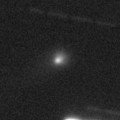
|
Now it is 15.4 mag (Oct. 28, Sandor Szabo). It will brighten up to 14 mag from 2015 to 2016. It is observable in good condition in the Southern Hemisphere. It locates somewhat low in the Northern Hemisphere.
Date(TT) R.A. (2000) Decl. Delta r Elong. m1 Best Time(A, h)
Dec. 6 4 0.20 -24 49.0 4.053 4.761 131 15.3 22:58 ( 0, 30)
Dec. 13 3 49.40 -24 8.2 4.065 4.734 127 15.3 22:20 ( 0, 31)
|
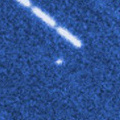
|
Now it is 18.6 mag (Oct. 4, D. Herald). It will brighten up to 9 mag in 2015 spring. But the condition of this apparition is bad. In the Southern Hemisphere, it keeps observable until winter when the comet will be 13 mag. But it is not observable around the brightest days. In the Northern Hemispehre, it keeps extremely low and hard to observe. It will be observable after 2015 autumn when the comet will fade out.
Date(TT) R.A. (2000) Decl. Delta r Elong. m1 Best Time(A, h)
Dec. 6 21 23.21 -42 28.2 2.616 2.281 59 15.5 18:18 ( 21, 8)
Dec. 13 21 35.88 -40 57.8 2.628 2.230 55 15.3 18:19 ( 24, 9)
|
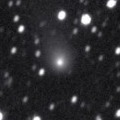
|
Now it is 14.2 mag (Oct. 4, Jakub Cerny). It keeps 13-14 mag and observable in good condition in the Northern Hemisphere for a long time from 2013 to 2014. It locates low in the Southern Hemisphere. Two fragments, B and C, are also visible at 18-20 mag.
Date(TT) R.A. (2000) Decl. Delta r Elong. m1 Best Time(A, h)
Dec. 6 22 35.33 22 42.9 4.440 4.641 95 15.4 18:18 ( 40, 75)
Dec. 13 22 36.50 21 12.9 4.594 4.681 88 15.5 18:19 ( 53, 69)
|
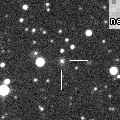
|
Now it is 15.7 mag (Nov. 13, A. Klotz, F. Kugel, J. Nicolas). In the Northern Hemisphere, it keeps 15-16 mag and observable in excellent condition for a long time until early summer in 2015. In the Southern Hemisphere, it is not observable until mid January.
Date(TT) R.A. (2000) Decl. Delta r Elong. m1 Best Time(A, h)
Dec. 6 12 54.76 33 14.0 3.599 3.541 78 15.8 5:23 (262, 58)
Dec. 13 13 2.74 32 57.6 3.534 3.551 82 15.7 5:28 (265, 63)
|
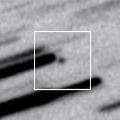
|
Now it is 15.3 mag (Nov. 27, Mt. Lemmon Survey). It will pass the perihelion on Mar. 15. In the Northern Hemispehre, it keeps observable in good condition until late February. In the Southern Hemisphere, it keeps observable until mid February, but it locates low.
Date(TT) R.A. (2000) Decl. Delta r Elong. m1 Best Time(A, h)
Dec. 6 3 20.68 35 43.4 0.794 1.743 156 15.8 22:18 (180, 89)
Dec. 13 2 50.44 32 43.0 0.769 1.678 145 15.8 21:20 ( 0, 88)
|
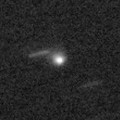
|
It will approach to the sun down to 0.3 a.u. in 2015 July, and it is expected to be bright. Now it is 16.3 mag (Nov. 12, K. Hills). It keeps observable while the comet will be brightening gradually until January when the comet will be 15 mag. The condition is bad after that and it will be hard to observe. But in the Southern Hemisphere, it will be observable after mid July in 2015, and keeps observable while the comet will be fading gradually. In the Northern Hemisphere, it is extremely hard to observe after 2015.
Date(TT) R.A. (2000) Decl. Delta r Elong. m1 Best Time(A, h)
Dec. 6 22 47.42 -26 10.5 3.667 3.629 80 15.9 18:18 ( 8, 29)
Dec. 13 22 47.80 -25 16.4 3.692 3.543 73 15.8 18:19 ( 15, 28)
|
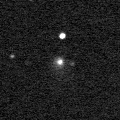
|
Now it is 16.2 mag (Oct. 27, Sandor Szabo). It keeps observable at 15-16 mag for a long time from 2015 to 2016. In the Northern Hemisphere, it is observable in excellent condition. It locates somewhat low in the Southern Hemisphere.
Date(TT) R.A. (2000) Decl. Delta r Elong. m1 Best Time(A, h)
Dec. 6 3 22.28 25 56.4 4.734 5.670 159 15.9 22:21 ( 0, 81)
Dec. 13 3 16.89 26 20.3 4.761 5.649 152 15.9 21:48 ( 0, 81)
|
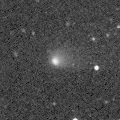
|
It is bright as 14.1 mag still now (Oct. 25, Seiichi Yoshida). It will be fading after this. But it keeps observable until March when it becomes fainter than 18 mag.
Date(TT) R.A. (2000) Decl. Delta r Elong. m1 Best Time(A, h)
Dec. 6 23 51.80 -13 10.3 2.018 2.381 99 16.1 18:52 ( 0, 42)
Dec. 13 23 59.04 -12 12.8 2.113 2.394 94 16.2 18:32 ( 0, 43)
|
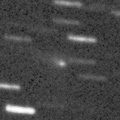
|
First return of a new periodic comet discovered in 2004. It brightened very rapidly as expected. Now it is 16.4 mag (Oct. 28, Catalina Sky Survey). It will be observable in excellent condition from autumn to winter.
Date(TT) R.A. (2000) Decl. Delta r Elong. m1 Best Time(A, h)
Dec. 6 23 37.36 5 54.6 0.814 1.417 103 16.2 18:39 ( 0, 61)
Dec. 13 0 0.50 6 16.8 0.855 1.431 101 16.3 18:34 ( 0, 61)
|
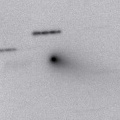
|
It brightened up to 13.8 mag from summer to autumn (Sept. 16, Taras Prystavski). Now it is fading rapidly. It has already faded down to 17.1 mag (Nov. 9, K. Hills). It keeps observable in good condition until February when the comet will be fainter than 18 mag.
Date(TT) R.A. (2000) Decl. Delta r Elong. m1 Best Time(A, h)
Dec. 6 0 6.75 -4 39.5 2.134 2.586 106 16.3 19:07 ( 0, 50)
Dec. 13 0 13.00 -3 54.1 2.249 2.617 100 16.5 18:46 ( 0, 51)
|
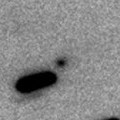
|
Now it is 17.0 mag (Oct. 18, Ken-ichi Kadota). It will brighten up to 16 mag and will be observable in excellent condition in winter.
Date(TT) R.A. (2000) Decl. Delta r Elong. m1 Best Time(A, h)
Dec. 6 11 23.52 6 43.6 1.884 2.042 84 16.4 5:23 (330, 58)
Dec. 13 11 34.35 6 3.2 1.820 2.053 88 16.3 5:28 (340, 60)
|

|
Now it is 15.9 mag (Nov. 29, Ken-ichi Kadota). It will be higher gradually, and will be observable at 16-17 mag in good condition from winter to spring. It will be observable after January also in the Southern Hemisphere.
Date(TT) R.A. (2000) Decl. Delta r Elong. m1 Best Time(A, h)
Dec. 6 14 9.66 -5 23.1 2.440 1.831 41 16.4 5:23 (295, 23)
Dec. 13 14 27.35 -6 29.0 2.407 1.840 44 16.4 5:28 (299, 25)
|
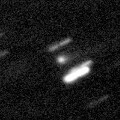
|
Now it is 16.8 mag (Oct. 30, Catalina Sky Survey). It will brighten up to 16 mag in winter, and will be observable in excellent condition.
Date(TT) R.A. (2000) Decl. Delta r Elong. m1 Best Time(A, h)
Dec. 6 8 27.88 13 12.5 3.408 4.081 127 16.4 3:30 ( 0, 68)
Dec. 13 8 26.90 13 1.7 3.331 4.082 134 16.4 3:02 ( 0, 68)
|

|
Now it is 16.8 mag (Nov. 15, J. F. Hernandez). It will pass close to the earth from spring to summer in 2016, and it is expected to be observable at 6-7 mag in good condition. In the Northern Hemispehre, it keeps observable in good condition until 2015 spring when the comet will brighten up to 15.5 mag. In the Southern Hemisphere, it keeps low for a long time until 2016 spring.
Date(TT) R.A. (2000) Decl. Delta r Elong. m1 Best Time(A, h)
Dec. 6 6 24.04 36 11.7 5.006 5.915 155 16.7 1:27 (180, 89)
Dec. 13 6 15.68 36 27.6 4.909 5.853 161 16.6 0:52 (180, 89)
|
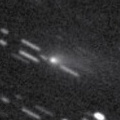
|
It brightened up to 2 mag by unusual major outburst in 2007. It brightened up to 12.6 mag in this apparition (June 25, Taras Prystavski). Now it is fading. It has already faded down to 16.3 mag (Nov. 15, J. F. Hernandez). In the Northern Hemisphere, it keeps observable until it fades out in 2015. In the Southern Hemisphere, it keeps extremely low after this.
Date(TT) R.A. (2000) Decl. Delta r Elong. m1 Best Time(A, h)
Dec. 6 4 29.70 50 5.0 1.860 2.769 152 16.8 23:28 (180, 75)
Dec. 13 4 21.49 49 21.0 1.895 2.799 151 17.0 22:53 (180, 76)
|

|
Now it is 17.2 mag (Oct. 28, E. Bryssinck). It will brighten up to 13 mag in 2016. In the Northern Hemisphere, it will be observable at 16 mag in excellent condition in this winter. It locates somewhat low in the Southern Hemisphere.
Date(TT) R.A. (2000) Decl. Delta r Elong. m1 Best Time(A, h)
Dec. 6 6 31.00 27 56.4 2.379 3.305 156 17.0 1:34 ( 0, 83)
Dec. 13 6 25.49 28 6.9 2.321 3.280 164 16.9 1:01 ( 0, 83)
|
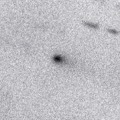
|
It brightened up to 14.6 mag in summer (July 8, Hidetaka Sato). Now it is fading. It has already faded down to 17.2 mag (Oct. 30, Catalina Sky Survey). It is fading much faster than predicted. The condition is good in the Northern Hemispehre. It keeps observable until next February when the comet will be fainter than 18 mag. It locates somewhat low in the Southern Hemisphere.
Date(TT) R.A. (2000) Decl. Delta r Elong. m1 Best Time(A, h)
Dec. 6 8 45.06 13 10.7 1.598 2.292 123 17.0 3:47 ( 0, 68)
Dec. 13 8 42.74 13 17.6 1.570 2.337 130 17.1 3:18 ( 0, 68)
|
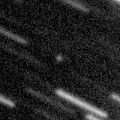
|
Peculiar asteroid with a cometary orbit of 45-years period. Now it is 18.3 mag (Oct. 4, M. Jaeger, et al.). It will brighten up to 17 mag from November to December, and will be observable in excellent condition.
Date(TT) R.A. (2000) Decl. Delta r Elong. m1 Best Time(A, h)
Dec. 6 4 2.19 10 45.7 1.819 2.779 163 17.2 23:00 ( 0, 66)
Dec. 13 3 42.33 7 43.7 1.887 2.795 152 17.4 22:13 ( 0, 63)
|
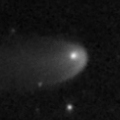
|
Now it is 17.8 mag (Oct. 21, C. Bell). It brightened up to 13 mag from 2011 to 2012. It will be fading after this, but it keeps brighter than 18 mag until 2015 spring.
Date(TT) R.A. (2000) Decl. Delta r Elong. m1 Best Time(A, h)
Dec. 6 3 21.58 -4 11.4 8.385 9.218 145 17.2 22:21 ( 0, 51)
Dec. 13 3 18.64 -3 55.8 8.477 9.253 140 17.2 21:50 ( 0, 51)
|
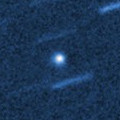
|
Now it is 16.9 mag (Nov. 18, R. Ligustri). It keeps 13 mag for a long time from 2015 to 2016, and will be observable in excellent condition in the Northern Hemisphere. In the Southern Hemisphere, it is observable only until mid 2015 March.
Date(TT) R.A. (2000) Decl. Delta r Elong. m1 Best Time(A, h)
Dec. 6 4 29.94 17 26.8 4.199 5.179 173 17.3 23:29 ( 0, 73)
Dec. 13 4 23.01 17 55.5 4.168 5.128 165 17.2 22:54 ( 0, 73)
|
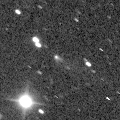
|
Now it is 18.1 mag (Oct. 1, Catalina Sky Survey). It was observed at 17 mag from 2013 to early 2014. It will be observable at 17.5 mag in good condition again from autumn to winter in 2014.
Date(TT) R.A. (2000) Decl. Delta r Elong. m1 Best Time(A, h)
Dec. 6 8 41.82 13 2.4 2.635 3.290 124 17.4 3:44 ( 0, 68)
Dec. 13 8 40.81 12 51.4 2.570 3.303 131 17.3 3:16 ( 0, 68)
|
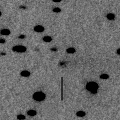
|
Now it is 18.6 mag (Oct. 24, Ken-ichi Kadota). It keeps observable at 17-18 mag from summer to winter in excellent condition in the Northern Hemisphere. It locates somewhat low in the Southern Hemisphere.
Date(TT) R.A. (2000) Decl. Delta r Elong. m1 Best Time(A, h)
Dec. 6 7 5.13 19 37.3 1.692 2.581 148 17.4 2:08 ( 0, 75)
Dec. 13 7 0.00 20 6.1 1.677 2.610 156 17.5 1:35 ( 0, 75)
|
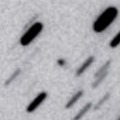
|
Now it is 17.6 mag (Oct. 24, Ken-ichi Kadota). It was observed around 17-18 mag in early 2014. It will be observable around 17-18 mag again from 2014 autumn to 2015 spring, in excellent condition in the Northern Hemisphere. It is not observable in the Southern Hemisphere.
Date(TT) R.A. (2000) Decl. Delta r Elong. m1 Best Time(A, h)
Dec. 6 10 53.98 54 38.6 4.745 5.126 107 17.5 5:23 (194, 70)
Dec. 13 10 56.19 54 59.4 4.679 5.130 112 17.5 5:28 (181, 70)
|

|
It brightened up to 12-13 mag from 2012 to 2013. Now it is fading. But it is bright as 16.7 mag still now (Nov. 8, K. Hills). It keeps 16-17 mag until autumn, and will be observable in good condition.
Date(TT) R.A. (2000) Decl. Delta r Elong. m1 Best Time(A, h)
Dec. 6 0 14.25 -16 8.6 3.874 4.200 102 17.5 19:14 ( 0, 39)
Dec. 13 0 15.42 -15 27.0 3.993 4.216 96 17.6 18:48 ( 0, 40)
|

|
First return of a peculiar asteroid 1998 HO121. It keeps observable at 17-18 mag from 2015 to 2016.
Date(TT) R.A. (2000) Decl. Delta r Elong. m1 Best Time(A, h)
Dec. 6 7 25.09 6 23.2 2.557 3.364 139 17.7 2:28 ( 0, 61)
Dec. 13 7 23.05 6 9.6 2.482 3.342 145 17.5 1:58 ( 0, 61)
|
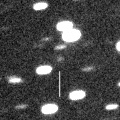
|
Now it is around the aphelion. In the Northern Hemisphere, it is observable at 17.5 mag in good condition from winter to spring. It locates somewhat low in the Southern Hemisphere.
Date(TT) R.A. (2000) Decl. Delta r Elong. m1 Best Time(A, h)
Dec. 6 9 21.41 25 1.2 4.136 4.683 118 17.9 4:24 ( 0, 80)
Dec. 13 9 20.80 25 20.9 4.035 4.675 125 17.9 3:56 ( 0, 80)
|
|
![]()
 269P/2012 R2 ( Jedicke )
269P/2012 R2 ( Jedicke ) C/2013 X1 ( PanSTARRS )
C/2013 X1 ( PanSTARRS ) 17P/Holmes
17P/Holmes 116P/Wild 4
116P/Wild 4 16P/Brooks 2
16P/Brooks 2 2013 NS11
2013 NS11 C/2009 F4 ( McNaught )
C/2009 F4 ( McNaught ) C/2014 W2 ( PanSTARRS )
C/2014 W2 ( PanSTARRS ) 119P/Parker-Hartley
119P/Parker-Hartley 191P/McNaught
191P/McNaught C/2013 U2 ( Holvorcem )
C/2013 U2 ( Holvorcem ) 246P/2010 V2 ( NEAT )
246P/2010 V2 ( NEAT ) (347449) 2012 TW236
(347449) 2012 TW236 65P/Gunn
65P/Gunn![]()















































